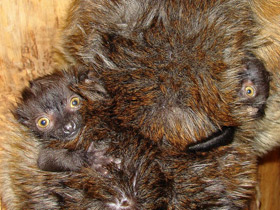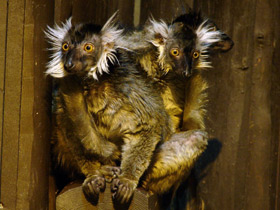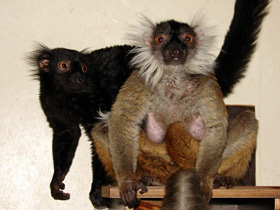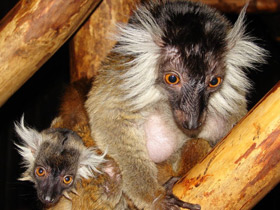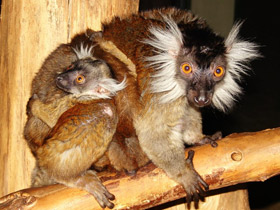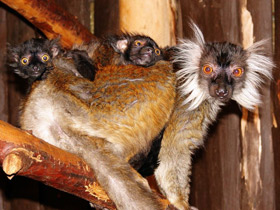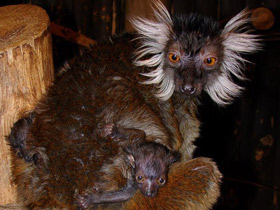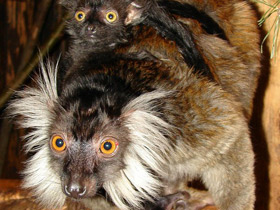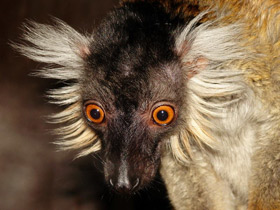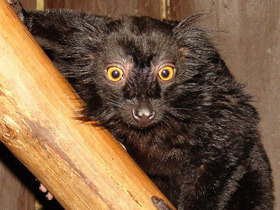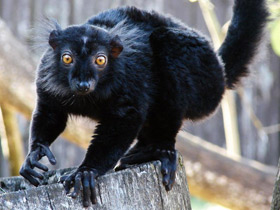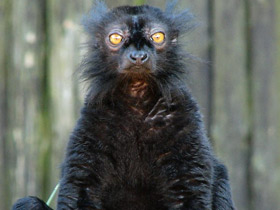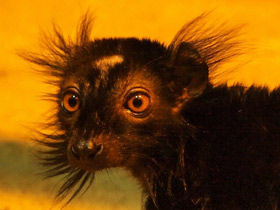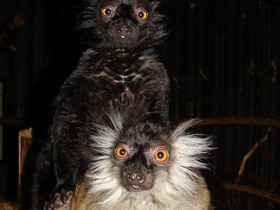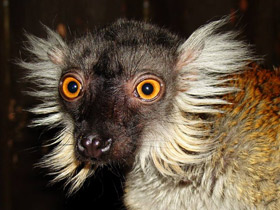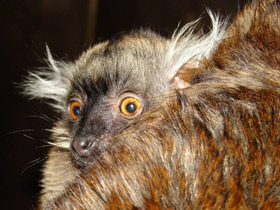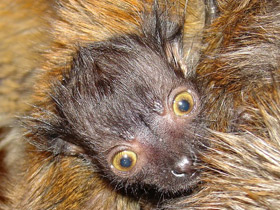The black lemur (Eulemur macaco)
 The black lemur (Eulemur macaco) is included in the IUCN Red List as Vulnerable
The black lemur (Eulemur macaco) is included in the IUCN Red List as Vulnerable
Habitat area
The black lemur (Eulemur macaco) is a species of lemur from the family Lemuridae.
The eulemur macaque only inhabits the Sambirano region of northwestern Madagascar and several nearby islands, Nusi-Be and Nusi-Comba, where it lives in humid forests, although it may also live in secondary forests. These primates walk or run on all fours in trees or on the ground, but may occasionally make short runs on two legs. They use their powerful hind legs to leap from branch to branch or tree to tree.
Appearance
The black lemur (Eulemur macaco) is a small, cat-sized animal, covered with long, soft fur. Its body length reaches 30-45 cm and tail length - 55 cm, and the body weight of adult lemurs averages 2.5 kg.
The eyes of the eulemur macaque are forward-facing, so they have stereoscopic vision. Their snouts are black, narrow and fox-like, and their ears are tufted: black in males and white in females.
The animals are sexually dimorphic, with males and females painted differently.
Males are monochromatic black, but in sunlight their coat may show a reddish-brown to dark brown tinge. Clumps of hair can be seen on their ears.
Females are brown to black-brown on the back, the limbs brown and the belly light brown to pale grey. Head and muzzle dark grey, long tufts of white ear hair in females.
Both sexes have very long fluffy tails. The eyes of these animals are orange-yellow, which distinguishes them from their closely related species, the brown lemur.
Reproduction
The mating season of the eulemur macaque is from June to July, gestation lasts 126 days and the young (1 per year) are born between September and November.
The young cling to their mother's fur and stay with her on her chest for the first three weeks, then travel on her back.
At three weeks of age it takes its first independent steps and tastes its mother or other members of the group as a staple food.
At five to six months of age, it becomes fully independent and separates from its mother.
At two years of age, young lemurs reach sexual maturity.
Their lifespan can reach 20-25 years.
Lifestyle
Macaque eulemurs have a lifestyle and activity pattern virtually unique among primates and rarely seen among other species: they are active 24 hours a day.
However, peak activity occurs in the early morning and late afternoon. Macaque eulemurs can forage both day and night.
They can obtain some food only at night, for example, nectar from the flowers of the Parkia tree is available only after dusk, when the flowers of this plant are in full bloom.
Macaque eulemurs feed mainly on ripe fruit, but also eat flowers, leaves, mushrooms and sometimes various invertebrates, such as insects and millipedes. Feeding varies seasonally, with nectar playing an important role during the dry season.
At night, several neighbouring groups may gather. Here they engage in grooming, thus expressing loyalty and sympathy for other members of the group. The structure of the teeth of the lower jaw (their lower incisors are inclined forward at an angle of about 45°) resembles a comb, which is used for grooming (removal of parasites and foreign debris).
Social behaviour
Macaque eulemurs live in family groups of 4 to 15 individuals (7 to 10 on average). Females lead the family and are dominant over males.
Macaque eulemurs are territorial animals. Group territories may cover 5 to 6 hectares, and the areas of neighbouring groups partially overlap. Vocalisation, scent marks, body postures and facial expressions as well as tactile communication are used to protect their territories.
Macaque eulemurs mark surrounding objects with scent secretion by applying their scent from special glands in the anal region, and males also mark with scent glands located on the forearms and head. This scent carries important information about the status of each animal and is a kind of individual calling card.
Macaque eulemurs also have highly developed vocal communication. Among the sounds they use are: "clutch call", used to maintain communication between members of different groups; "recognition grunt", used when one macaque eulemur identifies another (these sounds somewhat resemble the quacking of a duck); "purr", used by babies to demonstrate contentment; "signal call", used to alert other lemurs to the arrival of predators (e.g. birds of prey or ground predators such as wyverns).
Diet
The black lemur primarily eats fruit, which makes up an estimated 78% of its diet. The ripeness of this fruit is vital to the lemur's diet. Other foods eaten include flowers, leaves, fungi, some invertebrates and, especially during the dry season, nectar.

















